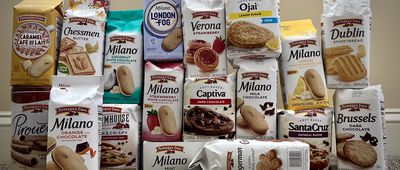Best Cheap Juicers
Juices have gone way beyond the standard supermarket jugs of orange and apple to combine all manner of fruits and vegetables, from carrots and cucumber to leafy greens and grapefruit. Fresh-made and bottled juices sell at a premium in virtually every coffee bar and convenience store. By making your own juices at home, you can save money and control the ingredients (store-bought juices are notorious for their high sugar content). As juicing has grown in popularity, the options for cheap juicers have also proliferated. While they may not be as powerful as their more expensive counterparts, low-priced models from manufacturers such as Hamilton Beach, Black & Decker, and Lexen make juicing at home a smart, healthful, and easy choice for many consumers.
Our Top Pick


Cuisinart CCJ-500 Review
Pros:
- 3 choices for pulp control.
- "Final spin" option gets the last bit of juice out of the pulp.
- Dishwasher-safe parts and easy to clean in under a minute, users say.
- Stable on countertop.
- Compact enough to store easily.
Cons:
- Spout is made of flimsy plastic and liable to break off, according to online reviews.
- Inconvenient for making large quantities of juice, as pulp and seeds must be cleaned out periodically.
- Pulp sometimes clogs the spout.
- Some buyers report that it broke down after a short time.
Takeaway: The winning feature of this 25-watt electric reamer has to be the "final spin" option, which leaves no drop of juice unsqueezed, users report. In other words, users feel like they get their money's worth from the produce they buy for juicing. This Cuisinart juicer is easy to operate by simply pressing half a citrus fruit on the reamer. The reamer's universal size should fit any type of citrus, from limes to grapefruits. Many reviewers appreciate the ability to select how much pulp goes into the final product, which is a real differentiator.

Hamilton Beach 67602 Review
Pros:
- Powerful for the price.
- Wide 3-inch chute.
- Easy to clean; includes a cleaning brush and dishwasher-safe parts.
- Easy to operate -- with 1 speed, it's just on-off.
- Processes most fruits and hard vegetables very well, as long as they're cut into pieces, reviewers say.
- Users report making at least 1 quart of juice before the pulp bin needs to be cleaned out.
Cons:
- Not stable enough, according to some reviews -- tends to move around the countertop while running.
- Doesn't extract all the juice on the first pass; some users put the pulp through again to get more.
- No pitcher or carafe included.
Takeaway: This 800-watt centrifugal juice extractor is a great starter juicer, according to its fans. Ease of use is a big reason -- there is nothing to do but switch it on -- and price is another. The Hamilton Beach 67602 Big Mouth Juice Extractor performs fine with most fruits and vegetables but, like many centrifugal juicers, it has trouble extracting much juice from leafy greens. Both the manufacturer and users recommend putting a plastic bag in the pulp bin to ease cleanup.

Gourmia GJ750 Review
Pros:
- 2 speeds, one for fruits and one for hard vegetables.
- Powerful enough to liquify hard fruits and vegetables like carrots or beets.
- User-friendly for beginners.
- Extracts most of the juice from fruits and vegetables -- even leafy greens, if they are packed tightly enough.
- Can handle large pieces of produce.
- Comes with a cleaning brush and carafe.
Cons:
- Funnel housing and juice cup are made of thin plastic that could break easily.
- Sometimes freezes when juicing hard root vegetables, reviewers warn.
- Some users report that this model has a short lifespan.
- Some buyers detect an awful odor out of the box.
Takeaway: Consumers starting out in the juicing world consider this 750-watt centrifugal extractor a good ally. Even some reviewers who have used expensive masticating juicers say it works very well. While the manufacturer says the Gourmia GJ750 Wide Mouth can handle whole fruits and vegetables, users suggest that cutting them in large chunks to make quick work of extraction.

Black & Decker JE2400BD Review
Pros:
- Easily juices fruits and most hard vegetables.
- Extremely affordable way to begin juicing.
- Compact size makes it easy to pull out of a cabinet and doesn't take up a lot of counter space.
- Dishwasher safe, and easy to clean manually.
Cons:
- Small mouth; produce must be cut into small pieces before juicing.
- Does not come with a juice container.
- Some users complain that it's extremely noisy.
- Some incidents of leakage and other breakdowns.
Takeaway: The 400-watt motor in this centrifugal juicer is strong enough to get most of the juice out of produce. It has one speed, which makes it simple for beginners to use -- just turn it on. Non-slip feet keep it steady. The Black & Decker JE2400BD 400-Watt Juice Extractor works extremely well for fruit but leaves vegetable juice behind, according to reviews. In CNET testing, it didn't stand out among centrifugal juicers for juicing leafy greens. The site's reviewer suggests alternating soft and hard foods to keep from clogging the mesh around the pulp container.

Brentwood JC-500 Review
Pros:
- 2 speeds, one for fruits and one for hard vegetables.
- Comes with a pitcher that separates the foam from the juice.
- Wide mouth means less time spent cutting up fruits and vegetables.
- Easy to take apart for cleaning and put back together; moving parts are dishwasher safe.
Cons:
- Some users say too much produce is left in the pulp, so they have to run it through twice.
- Some reviewers have had problems with leakage.
Takeaway: Consumers who are not sure whether juicing is for them have found the Brentwood JC-500 Juice Extractor an affordable and easy way to start the practice. This 800-watt centrifugal juicer is fast and powerful, although it does not seem to extract all the possible juice from produce. Some users are fine with putting the pulp through the juicer a second time, when it comes out mostly dry, but others say that detracts from the ease of the process. While this model works well on fruits and hard vegetables, like many juice extractors, it produces very little juice from leafy greens.

Proctor Silex 66331 Review
Pros:
- 2 reamers, for handling both small citrus fruits like lemons and large ones like grapefruit.
- Pulp control for people who prefer juice without pulp.
- Very efficient at extracting juice, according to user reviews.
- Compact and easy to store, yet holds a lot of juice.
- Easy to take apart and wash.
- Comes with a 34-ounce container.
- Wirecutter's pick for best citrus juicer.
Cons:
- On the noisy side, reviewers warn.
- A bit underpowered for large quantities of bigger citrus fruits.
- Some users report a lack of durability.
Takeaway: The Proctor Silex 66331 Alex's Lemonade Stand Citrus Juicer is as simple as can be. There is no setup; it's ready to go right out of the box, and juice dispenses directly into the attached container. Users say the machine is a snap to disassemble and clean; all the parts are dishwasher safe. The compact size makes it convenient to store even in a very small apartment kitchen. A dollar from every purchase goes to the Alex's Lemonade Stand Foundation, a charity for childhood cancer.

Brentwood J-15 Review
Pros:
- Works well for citrus fruits without seeds.
- Reamer reverses direction to get maximum juice out of fruit.
- Easy to clean.
- Small, so it doesn't take up much room, and easy to store.
- Comes with a 700 ml detachable pitcher.
Cons:
- Flimsy construction; the plastic cracks easily and pieces don't fit together tightly, according to reviews.
- Some users report that the motor dies unexpectedly.
- Not big enough for grapefruit.
Takeaway: This 25-watt citrus juicer is fine for the price if it isn't used much, but it's not constructed well enough to go through an entire basket of oranges. Adding any pressure at all to the fruit can stop the reamer from spinning, users say, and this lightweight juicer has a tendency to jump around on the counter. There is only one reamer, which is too small for larger citrus fruits.

Black & Decker JE2200B Review
Pros:
- Small footprint ideal for condo or apartment kitchens.
- Fast and easy to use.
- Most parts are easy to clean.
- Comes with a 300 ml juice collection cup.
Cons:
- Too much waste -- a lot of juice gets discarded in the pulp, reviewers say.
- Not powerful enough to juice a lot of produce without overheating.
- Some users accuse the blade of dulling quickly.
- Fruits and vegetables have to be cut into small pieces to fit through the mouth.
Takeaway: This 400-watt centrifugal juicer is not as powerful as most of our top picks, and it shows. Reviewers warn that it gets really hot when they try to put a lot of hard vegetables through it. The biggest issue, though, is that it doesn't make much juice -- a lot of pieces are left in the pulp container. It works well enough for the very low price, some users say, as long as expectations are not high.




















